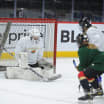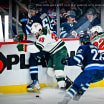This story appears in the November issue of Wild Magazine.
The NHL Draft class of 2003 has had a profound impact, not just on the NHL, but on the Minnesota Wild as a whole.
Considered by many experts as perhaps the greatest draft of all time, nearly half of players selected in the first round are still on NHL rosters almost 15 years after being picked. Many of those players are doing more than just collecting a paycheck; they are era-defining superstars and multiple-time All-Stars.
Draft class of 2003 one of NHL's best
Parise, Staal, Suter, Quincey were all selected by NHL teams in big draft year

Teams didn't just draft stars in the first round, either.
Dozens of good players were drafted in the middle and late rounds, while a handful of quality players were even drafted in the eighth and ninth rounds -- picks that no longer exist in a draft that lasts seven rounds.
"It's neat to think back," said Wild defenseman Ryan Suter, a 2003 draft pick. "I remember back to when [Thomas Vanek] came here. There was that picture of me, Zach [Parise] and Vanek all on the stairs in Nashville and we all looked so young. Then we were all playing on the same team after being drafted by different teams. It says a lot about our draft class, I think how good it really was with all the guys still playing."
Vanek, a former Golden Gopher who was selected fifth overall by the Buffalo Sabres, was bought out by the Wild following the 2015-16 season. He was replaced on the roster by another alum of the 2003 class, Eric Staal, picked second overall by the Carolina Hurricanes.
The class was bookended by goaltenders still thriving in the NHL, now almost 15 years after being picked by their teams.
The Pittsburgh Penguins picked Marc-Andre Fleury with the first overall pick. He won three Stanley Cups with the Penguins before being selected by the Vegas Golden Knights this past summer.
After nearly nine full rounds, Brian Elliott was picked 291st overall by the Ottawa Senators with the penultimate selection of the draft. He's approaching 400 career games in the NHL and signed as a free agent over the summer with the Philadelphia Flyers.
In between, the Wild and each of the other 28 teams made a series of selections that changed their teams -- and the League -- forever.
Of the four current Wild players selected in the 2003 Draft -- Parise, Suter, Staal and defenseman Kyle Quincey -- one was picked by Minnesota.
Suter and Parise signed as landmark free agents in July of 2012, forever changing the fortunes of the franchise.

Staal is in his second season with the club after signing a free-agent deal in July of 2016.
Quincey became the fourth member of the class to sign here when he inked a deal on July 1, 2017.
Suter and Parise knew years in advance they would likely end up as players picked in the same draft.
Suter grew up playing for the Madison Capitols, then at Culver Military Academy before going on to the United States Developmental Program in Ann Arbor. Parise played for his dad, J.P., at Shattuck-St. Mary's in Faribault.
The two played against each other on numerous occasions as they grew older, even skating against in college, when Suter played one season at the University of Wisconsin and Parise at the University of North Dakota -- then both prominent members of the Western Collegiate Hockey Association.
"You always knew he was gonna make it," Suter said of Parise. "When I was younger, I was never even thinking of the NHL. I was thinking about college. When I was playing against Zach, I remember thinking, 'Man, wherever he decides to go, we're going to be playing against each other all the way up.'"
That was the case in the NHL, as well.
Suter was selected seventh overall by the host club of the draft that year, the Nashville Predators. Parise was picked 10 spots later by the New Jersey Devils.
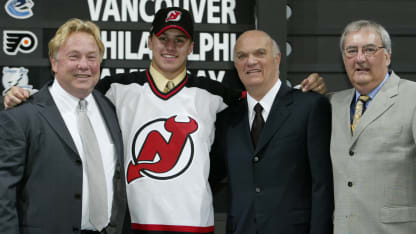
Each spent the 2004-05 lockout season in the American Hockey League. Each debuted in the NHL in 2005-06. Neither has left the League since and for the past six seasons, they've shared the same locker room.
"You never know how it's going to turn out," Parise said. "It was a long time in the making, but it doesn't seem that long. 15 years? It doesn't feel like it was that long ago."
Staal has the best draft pedigree of the Wild bunch, as he was picked behind only Fleury. He's also played the most games of the group in the NHL, having debuted in the League the fall after being picked.
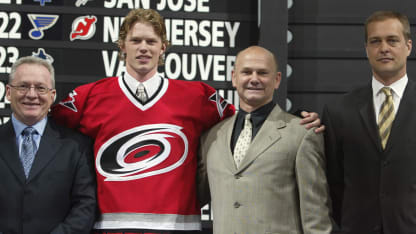
One of the most durable players of his generation, Staal has played in all 82 games seven times in his career (even playing in 83 games in 2015-16), and playing in 81 games two other times. In 13 NHL seasons, Staal has never played fewer than 70 games.
Staal leads the draft class in games played, goals and points and is second in assists. To be ranked so highly amongst a group considered among the best of all time says much about the career Staal has had.
"It's cool. Your dream is to make it to the NHL, and your dream and focus is to get to the NHL no matter how you get there," Staal said. "Over time, these kinds of things get talked about and it's kind of a neat thing to reflect on and talk about.
Quincey's path to the NHL and his ability to stick has been quite different.
Picked in the fourth round (132nd overall) by the Detroit Red Wings, Quincey didn't play his first full season in the NHL until the 2008-09 season, his first with the Los Angeles Kings. He had played in 13 NHL games combined with the club that drafted him the three seasons prior, putting in three nearly full seasons in the American League during that span.
Since that first full season in Los Angeles, Quincey has bounced around between five other teams, including the Avalanche, the Devils, the Blue Jackets, a second stint with the Red Wings and now the Wild.
Through it all, Quincey has stuck: If he stays healthy, he will play in his 600th NHL game later this season.
The rest of the League
In addition to Suter, Parise, Staal and Quincey, the 2003 NHL Draft class has left its mark on the NHL.
Nearly half of the players selected in the first round that year are still active in the League. Besides Staal (picked No. 2 overall), Suter (seventh) and Parise (17th), other first rounders still making impacts around the NHL include goaltender Marc-Andre Fleury (first), forwards Thomas Vanek (fifth), Jeff Carter (11th), Dustin Brown (13th), Ryan Getzlaf (19th), Ryan Kesler (23rd), Brian Boyle (26th), Corey Perry (28th) and Patrick Eaves (29th), and defensemen Braydon Coburn (eighth), Dion Phaneuf (ninth), Brent Seabrook (14th), Brent Burns (20th) and Mark Stuart (21st).
And those are just the first-rounders.
Forwards Loui Eriksson (33rd), Patrice Bergeron (45th) and David Backes (62nd), defenseman Shea Weber (49th) and goaltender Corey Crawford (52nd) were picked in the second round.
Quincey was a fourth-rounder. Lee Stempniak (148th) was a fifth-rounder. Marc Methot (168th) and Drew Miller (186th) were picked in round six. Joe Pavelski (205th) and Kyle Brodziak (214th) were seventh-round picks. Toby Enstrom (239th) and Dustin Byfuglien (245th) were eighth-round selections, a round that no longer exists in the NHL Draft.
Productive players were even found in the ninth and final round, including Matt Moulson (263rd), Tanner Glass (265th), Jaroslav Halak (271st), Chris Porter (282nd), David Jones (288th) and Brian Elliott (291st).
"Just a phenomenal class," Parise said. "I knew there were some real good players I played against along the way. But I think, having played against that group, you could tell at the time there were some great players."
The 2003 draft transformed franchises. Chicago picked Seabrook, Crawford and Byfuglien, all three of whom were instrumental in the Blackhawks winning their first Stanley Cup in nearly four decades. Seabrook and Crawford have been critical cogs in three Stanley Cup championships.
Draft host Nashville selected both Suter and Weber, changing the look of its defensive core for the remainder of the decade and laying the foundation that has made the Predators one of the best franchises in the NHL.
"It was pretty special [to be picked by Nashville]," Suter said. "I didn't really care where I went or who drafted me. I thought I was going to San Jose because my uncle played there and they were the pick before. But it's funny how everything works out. Being drafted by the hometown crowd was pretty cool to say the least."
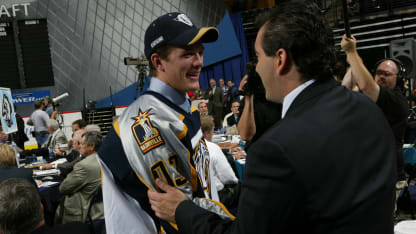
Anaheim used a pair of first-round picks to nab both Getzlaf and Perry, a duo that helped the club to a Stanley Cup in 2007 and six Pacific Division championships since.
The 2003 draft also transformed position groups. Among all defensemen in the NHL, Brent Burns, Weber and Byfuglien are first, second and fourth in goals scored since the 2011-12 season.
Burns has become a prototypical defenseman in today's swift skating, big shot defensemen. Weber has perhaps the NHL's hardest shot. Phaneuf, like Byfuglien, combine tremendous size with skill and athleticism. Suter, like Seabrook, is as steady as they come in both ends of the rink.
Others, like Quincey, Stuart, Enstrom, Methot, and even others, like Jan Hejda (627 NHL games) and Matt Carle (730 NHL games) have carved out steady, reliable careers.
"I have a lot of pride in that, knowing we were all drafted together and playing against each other all these years," Suter said.
All 30 players picked in the first round played, at some point, in the NHL. All but nine selected in the second round also reached the NHL.
"You had a lot of impact players, a lot of captains that came out of that class," Parise said. "It's a special group, some special players picked that year. It's amazing."














